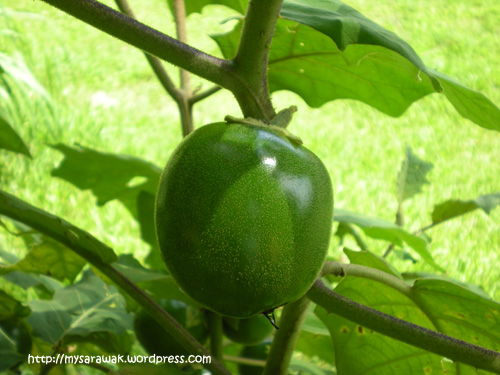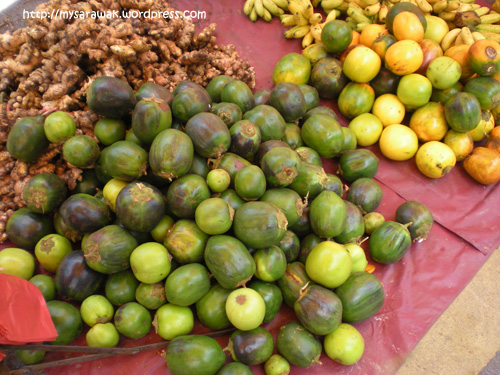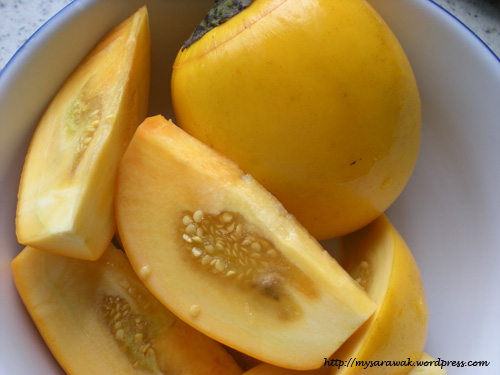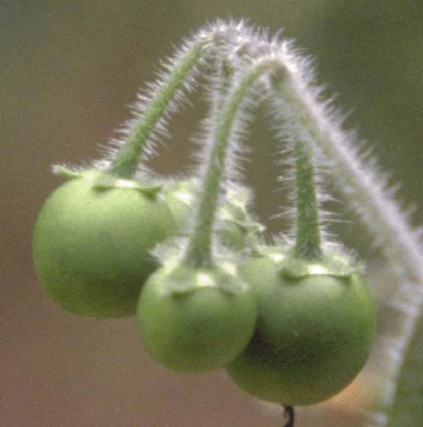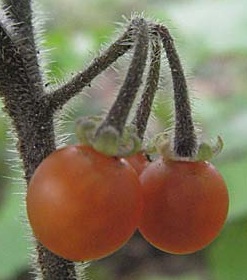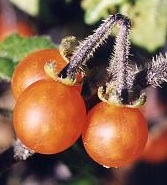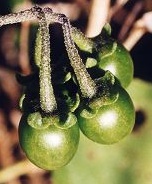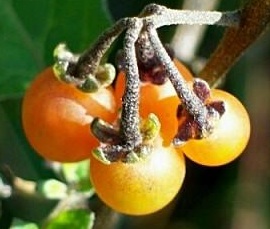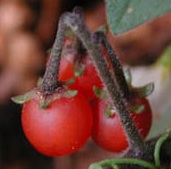Know your eggplants - Part 4
The related Nightshades

Solanum aculeatissimum Jacq.
Solanum
capsicoides All.
(Solanum aculeatissimum sensu
Schulz, non Jacq.
)
Solanum
incanum L. (Solanum
melongena L. var. incanum
(L.)
Kuntze)
Solanum indicum L.
Solanum
insanum L. (Solanum
melongena L. var. insanum
Prain)
Solanum
lasiocarpum Dunal (Solanum ferox L. (Terong
Asam Group)
Solanum
trilobatum L.
Solanum villosum
Mill.
Solanum violaceum Ortega
Solanum virginianum
L. (Solanum xanthocarpum Schrad.
& Wendl.)
Solanum viride
Spreng. (Solanum uporo
Dunal)
Back to Introductory page
Solanum
aculeatissimum
Jacq.
Synonyms : Solanum
horridum Salisb.
Straight off we
start with a taxonomical controversy.
The staff of the National Herbarium of New South Wales at the Royal
Botanic
Gardens & Domain Trust, Sydney, Australia, list Solanum aculeatissimum Jacq. as a
synonym of Solanum capsicoides
All. Many others, not the least of them the global taxonomic
resource for the nightshade family Solanaceae
, disagree and point to this error due to the fact that apparently
Schulz was
not considering the same plant as Jacq. When he named S. aculeatissimum
as a
synonym of S. capsicoides. This mistake is still repeated today and has
lead to
a great deal of confusion in the common names, many wrongly attributed
to
either one species or the other. "Cockroach berry" for example is
applied
to both species. The correct synonymy is: Solanum
aculeatissimum sensu
Schulz, non Jacq. = Solanum
capsicoides All. The preferred English name for
this species seems to be "Dutch
eggplant". There is a connection, possibly from the
many Malay names including the word "terong" (eggplant) in their
composition and the association of the Dutch people with Indonesia in
the past.
Similarly when the Thai lexicographers list Solanum xanthocarpum
Schrader & Wendl. as a synonym of Solanum aculeatissimum they
probably meant Solanum aculeatissimum
sensu Schulz, non Jacq. Again we cannot find confirmation of this
synonymy, but
certainly as a consequence some of the common names are mixed up a
little more. We have not
yet come across this but in the PROTA article Nicholson states: "
Misidentification of Solanum macrocarpon L. (synonym: Solanum
dasyphyllum
Schumach. & Thonn.) is a further source of confusion, probably in
West
Africa in particular". All these confusions probably arise from the
fact
that all these plants and their fruits look rather similar.
Contrary to Solanum aethiopicum, Solanum aculeatissimum has
travelled in the opposite direction, from its native Brazil it was
introduced
into Africa centuries ago. Today
it is present throughout tropical Africa and Asia.
Due to its resistance to Verticillium wilt (Verticillium dahliae),
a deadly disease of eggplants, it can be used as a rootstock for both
the
common eggplant and the common tomato. In Asia it is used to this end
in both
fields and hydroponic systems. The resistance to Verticillium wilt can
also be passed on to the
common eggplant and the Gboma eggplant (Solanum macrocarpon L.) via
crossbreeding. The Dutch eggplant will cross with any of these 2
successfully
but Nicholson warns that on occasions only sterile seeds will be
produced.This nightshade can be propagated from either
cuttings or seeds. Top Tropicals
is a possible source of plant material.
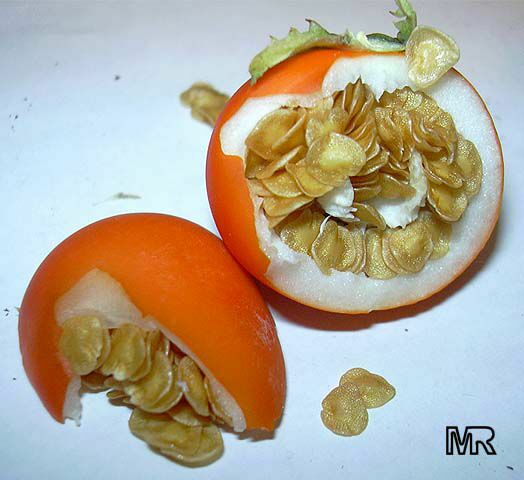
Photo courtesy Top Tropicals
reprinted from Solanum
aculeatissimum page.
Solanum
capsicoides
All.
Synonyms : Solanum aculeatissimum
sensu Schulz, non Jacq.
This species,
also native of Brazil, is fairly widespread in the Caribbean and the
fruits are
used to make juice. It has also been introduced in tropical Africa but
as an
ornamental. The
preferred name
for this plant seems to be " Devil's
apple ", although this is also used to
designate other species even with no relation whatsoever with
Solanaceae. We understand that this is a yellow-berried species,
whilst Solanum
aculeatissimum Jacq. is an orange / scarlet / red berried
nightshade. Is this correct?
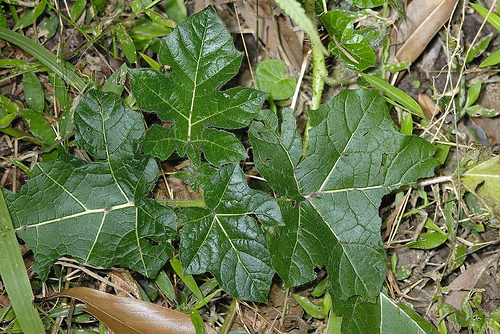
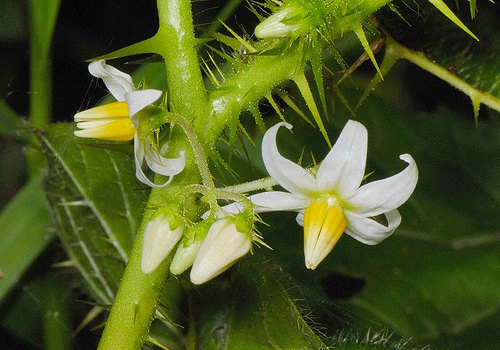
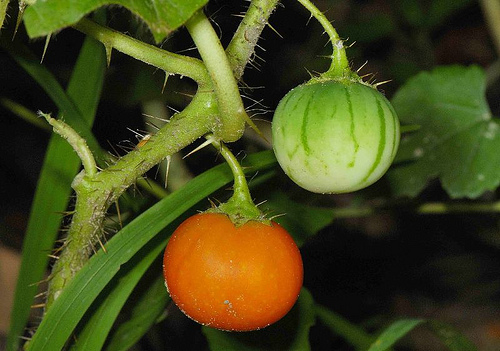
Reproduced from flickr with
permission of copyright owner Ming I
Weng
Leaves
Flowers
Fruits
Synonyms
: Solanum melongena
L. var. incanum (L.)
Kuntze
Like Solanum
insanum L. it is considered as a possible ancestor of
the modern eggplant. Solanum incanum L. is found throughout continental
Africa,
including South Africa. Its fruits are basically small, bitter and
toxic. It
grows wild in Madagascar and Mauritius where the fruits are considered
edible.
It also occurs from the Middle East to India. Selection for larger,
less toxic
fruits and leaves is taking place in West Africa as well as in the
former
French colonies, however wide variations in the toxicity of the fruits
and leaves
make it dangerous to transfer specific uses from one region to another.
As is
the case with many nightshades it is vital to know the plant one is
dealing
with, its edible parts, at what stage of development these parts are
edible,
and how to prepare and cook them.
The fruit and the seed are used in Africa and Asia to curdle milk and
to
make cheese. In Ethiopia the boiled fruits are used as soap and in the
tanning
of leather.
Due to its widespread occurrence this species is not in danger of
genetic erosion.
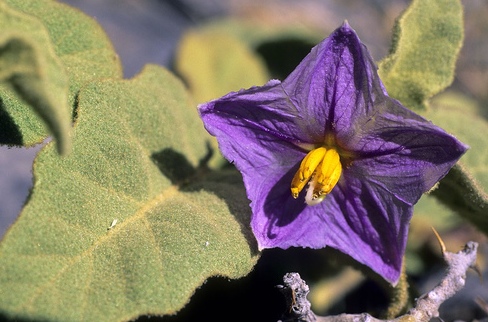
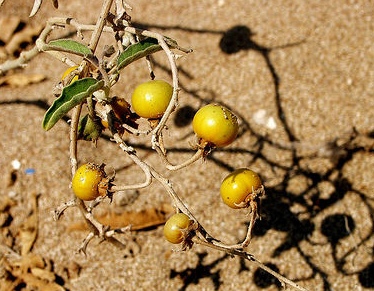
Reproduced from flickr with permission of copyright owner Drew Gardner
Flower and leaf
Reproduced from flickr with permission of copyright owner Benjamin Shafir
Fruits
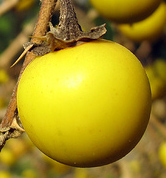
Yellow
fruit up to 8 mm in diameter.
This is
a species too difficult to focus on due to the unreliability of its
taxonomy. See A little
taxonomy "a complex example: Solanum indicum L."
Anything that could be said about it could equally apply to the many
plants that have been confused with it.
Synonyms
: Solanum melongena
L. var. insanum
Prain
Closely
related to Solanum melongena, perhaps a direct ancestor. Relatively
little background is available on this species.
Synonyms : Solanum ferox L. (Terong asam Group)
Based on the Malay vernacular and the reported (natives and travelers) strong association of Solanum lasiocarpum with Sarawak, we are guessing that this is Solanum ferox L. (Terong asam Group). The English names for this are either Wild brinjal or Sour brinjal, both being appropriate. Generally speaking Terong asam is wild but occasionally cultivated for its edible fruits in Southeast Asia, New Guinea and Sarawak in particular. The fruits are used in sauces and curries and like most of these (eggplant / nightshade borderline) plants have medicinal uses. There are 1 to 2 fruits per inflorescence on the plants. These round fruits are 2.5 to 3.5 cm in diameter and orange when ripe.
|
|
|
|
|
Reproduced
with permission from copyright owner Dianne
Lim |
Reproduced with permission from copyright owner Dianne Lim |
Reproduced
with permission from copyright owner Dianne
Lim |
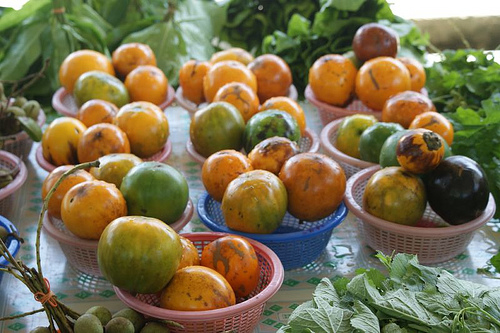
Reproduced from Flickr with permission from copyright owner XPing
Fruits in various stages of maturity at a market stall in Sarawak
See Solanum ferox L. (Terong asam Group) for more details.
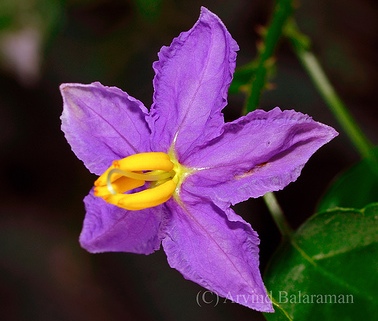
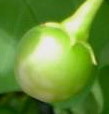
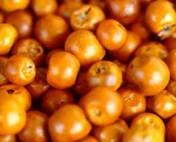
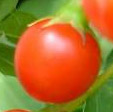
Fruits
Solanum villosum Mill.
|
|
|
|
|
subsp. villosum |
subsp. villosum |
subsp. villosum |
|
|
|
|
|
subsp. miniatum |
subsp. miniatum |
subsp. miniatum |
Solanum
virginianum
L.
Solanum xanthocarpum
Schrader & Wendl.
Surattense
nightshade is mostly a medicinal plant much utilised in
India but with a poisonous fruit.
Like many nightshades it is a potential source of disease resistant
material
for eggplants.
I am guessing that there are some
fruits of this species Yellow
berried nightshade in the photo below, I see mostly Kermit
looking
types,
the species of which I still am not sure. If one considers that Solanum
xanthocarpum can be a synonym of something else, my title is still
incorrect but only partially. The photo is so great however I could not
resist the temptation to include it.
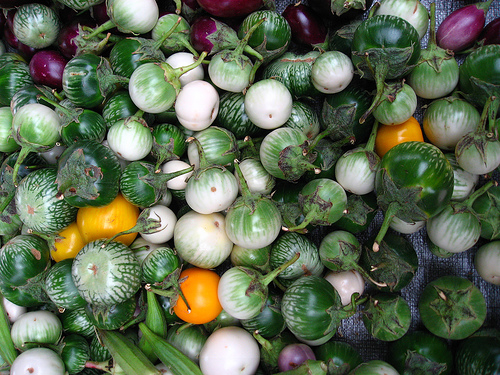
Reproduced from flickr with permission from copyright owner Eric Hunt
Not just Solanum xanthocarpum
The above photograph displays some Solanum melongena, Solanum torvum and Solanum xanthocarpum. We can see clearly some plain yellow berries (S. xanthocarpum), and striped yellow larger fruits which are most likely mature "Kermit" types.
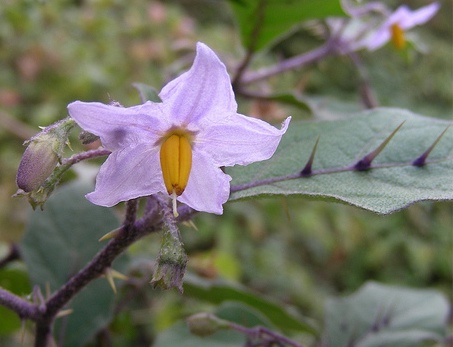
Reproduced from Flickr with permission from copyright owner Tanmay Shende
Flower
and
prickly leaf close-up
|
|
|
|
|
|
|
Unidentified
prickly |
Unidentified
prickly |
Unidentified
prickly |
Unidentified
smooth |
Unidentified
smooth |
Variations in
fruits of Solanum virginianum
L. from different origins at different stages of maturity
Solanum
viride
Spreng.
Synonyms : Solanum anthropophagorum
Seem., Solanum uporo
Dunal.
The epithet of the synonym Solanum anthropophagorum Seem. means "Solanum to eat with man" from the days when in Fiji human flesh was wrapped in its leaves, like fish is today, before cooking. It was then an edible green, a medicinal plant from the Polynesian region. Its fruits as can be gathered from some of the vernacular were used as adornments. In its native Fiji and established Cook Islands it was already considered endangered in 2004. Trade Winds Fruit sell the wild form of this plant with smaller round berries. The cultivars such as 'Anthropophagorum' from the Cook Islands and 'Borodina' from Fiji have larger fruits. The former has fruits very much reminiscent of the red jilo.
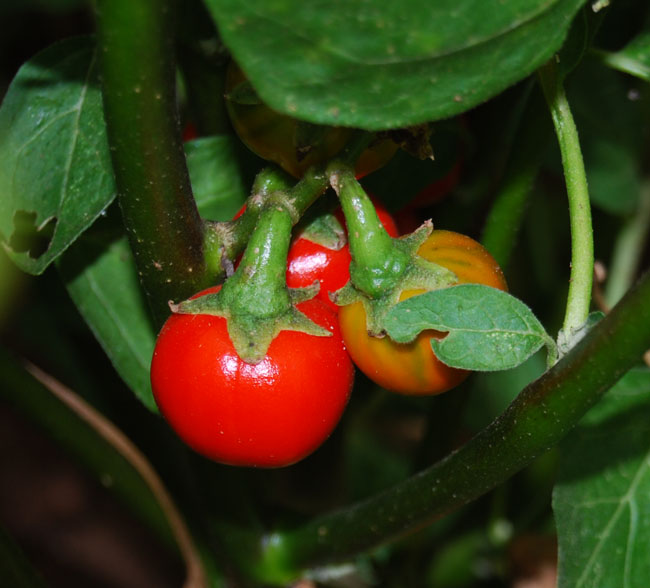
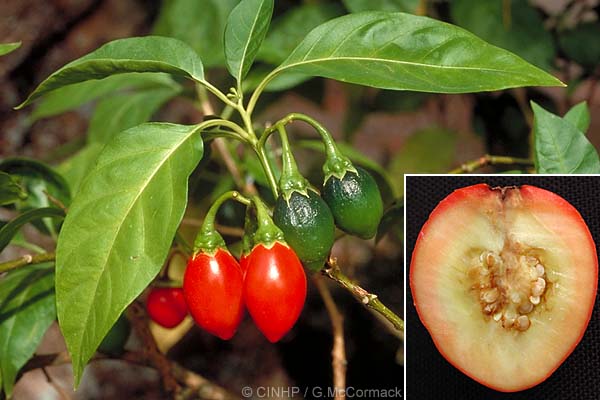
Reproduced from the Cook Islands Biodiversity Database & Website with permission from The Cook Islands Natural Heritage Trust.
Domesticated form
Manoko, M.L. & van der Weerden, G.M., 2004. Solanum villosum Mill. [Internet] Record from Protabase. Grubben, G.J.H. & Denton, O.A. (Editors). PROTA (Plant Resources of Tropical Africa / Ressources végétales de l’Afrique tropicale), Wageningen, Netherlands. < http://database.prota.org/search.htm>. Accessed 9 June 2009.
Matu, E.N., 2008. Solanum incanum L. [Internet] Record from Protabase. Schmelzer, G.H. & Gurib-Fakim, A. (Editors). PROTA (Plant Resources of Tropical Africa / Ressources végétales de l’Afrique tropicale), Wageningen, Netherlands. < http://database.prota.org/search.htm>. Accessed 12 June 2009.
McCormack, Gerald (2007) Cook Islands Biodiversity Database, Version 2007.2. Cook Islands Natural Heritage Trust, Rarotonga. Online at http://cookislands.bishopmuseum.org.
Nicholson, M.J., 2008. Solanum aculeatissimum Jacq. [Internet] Record from Protabase. Schmelzer, G.H. & Gurib-Fakim, A. (Editors). PROTA (Plant Resources of Tropical Africa / Ressources végétales de l’Afrique tropicale), Wageningen, Netherlands. < http://database.prota.org/search.htm>. Accessed 9 June 2009.
